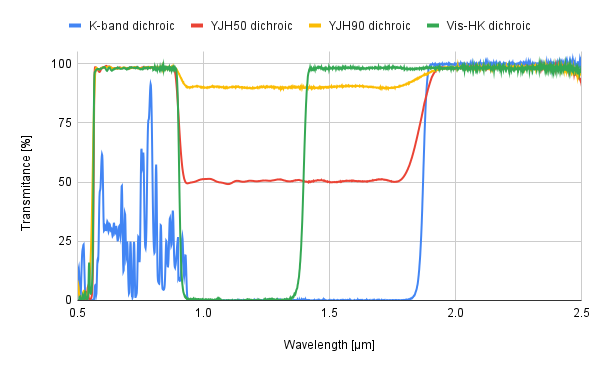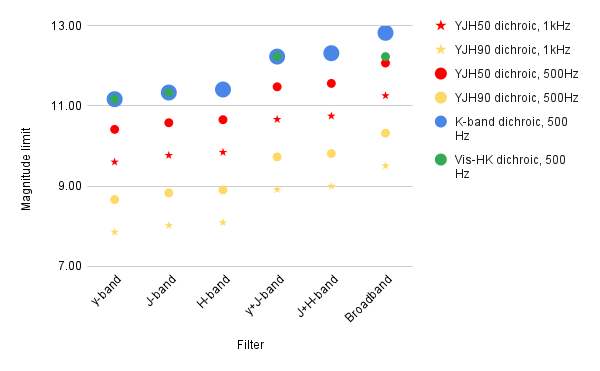
Near-IR Wavefront Sensor - Planning Observations
Please read section 1 carefully before submitting the proposal.
If you want to use the AO3k/NIRWFS, you need to find a Natural Guide Star (NGS) that is bright enough at less than 14" separation from your target of interest. The target of interest can be the NGS itself if it is a bright enough stellar object. Non-sidereal tracking is currently not available with NIRWFS.
Read the following instructions carefully if you wish to apply for observing time with AO188. If technical details described in your proposal are incomplete, it may be rejected even if your science case is great.
- 1. Information you have to describe in your proposal
- 2. Selecting AO guide stars
- 3. Planning dates of observations
- 4. Overheads
1. Information you have to describe in your proposal
The following should be clearly stated in the proposal.
- H-band (or J-band if the Vis-HK Dichroic is used) magnitude of your AO guide stars (see section 2 for details).
- One or several choices for the dichroic beamsplitter used, depending on the brightness of the NGs (see section 2 for details).
- Separation between your targets and AO guide stars (see section 2 for details).
- Strehl ratio and/or FWHM of the point-spread function (PSF) required for your project.
- Whether the AO guide star is a point source or not. If you use an extended object, or a binary object, you must discribe the geometry of the source (size for extended objects, separation and contrast for binaries) (see section 2 for details).
- Schedule requirement to avoid the moon's glare which severely degrades the AO loop performance (see section 3 for details).
- Other usual requirements for the science instrument used (IRCS, SCExAO). Please check their respective webpages
2. Selecting AO guide stars
Throughput and Dichoic Choice
 |
|---|
|
|
Magnitude Limit
Magnitude limits listed in this section are for the AO correction to deliver 0.1 arcsec FWHM in median conditions. AO correction perfomance at the faint limit is strongly affected by atmospheric conditions, including turbulence coherence time. Magnitude values are calculated for A-type stars with flat spectra. Very red objects will be limited by the H-band magnitude limit before the broadband magnitude limit.The values presented here were measured with the first design of the NIRWFS. The upgrade in S25B will change these values, and a new binning mode should improve the magnitude limit to about one magnitude, but this mode might not yet be available in S26A.
| Filter | Dichroic | |||
|---|---|---|---|---|
| K-band | YJH50 | YJH90 | Vis-HK | |
| Y-band | mY=11.2 | mY=10.4 | mY=8.7 | mY=11.2 |
| J-band | mJ=11.3 | mJ=10.6 | mJ=8.8 | mJ=11.3 |
| H-band | mH=11.4 | mH=10.7 | mH=8.9 | N/A |
| Y+J-band | mJ=12.2 | mJ=11.5 | mJ=9.7 | mJ=12.2 |
| J+H-band | mH=12.3 | mH=11.6 | mH=9.8 | N/A |
| Broadband | mH=12.8 | mH=12.1 | mH=10.3 | mJ=12.2 |
Separation for off-axis NGS
If the science target is too faint, then you need to select a bright NGS that is no more than 14" away from it. This limitation is due to the capture field-of-view of the NIRWFS (See Performance for more details).
Extended objects and binaries
The pyramid WFS design is not ideal for extended objects and binaries. For extended sources, if the source is too extended (more than a few arcseconds), the loop cannot close. For smaller objects, we can close the loop, but with degraded performances. For binaries, results can vary depending on the separation and H-band contrast between the two stars. Separations over ~3" should have no impact whatever the contrast is, and similarly, contrasts over ~5 should also have no impact whatever the separation is. For separations between 1 and 3", a low-contrast binary will be difficult to observe, due to the added light of the companion inside the wavefront sensor. If the separation is closer, we have more chances to close the loop, although the performances might be affected.
A new adaptive field stop will be added in S25B, and should improve the capacity to close the loop for binaries and crowded fields.
3. Planning dates of observations
Evaluate possible dates of your observations based on the following tips:- Elevation --- We recommend you to observe targets at an elevation of 45o or larger. Strehl ratios and/or FWHMs can significantly be degraded at lower elevations. Please not that the atmospheric dispersion corrector (ADC) installed at the science path, or the wavefront sensor do not guarantee good correction for elevations below 30o.
- Distance to the moon --- We cannot perform AO correction if the sky is very bright. We then recommend you to observe the target at least 10o apart from the moon.
